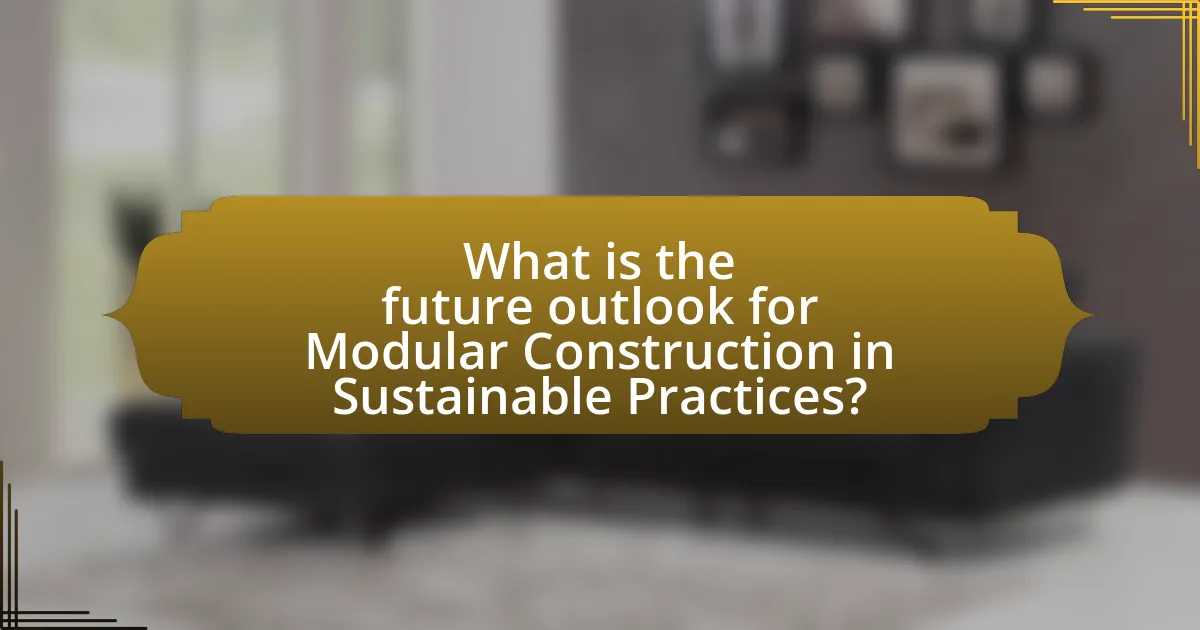Modular construction represents a transformative approach in sustainable building practices, utilizing prefabricated sections manufactured off-site to minimize waste and enhance efficiency. This method can reduce construction waste by up to 90% and operational energy use by 20-30%, significantly lowering the carbon footprint of buildings. Key principles include resource efficiency, waste reduction, and energy performance optimization, supported by advancements in technology such as Building Information Modeling (BIM) and automation. Current trends highlight the integration of eco-friendly materials and energy-efficient designs, while challenges such as regulatory hurdles and public perception persist. The future of modular construction is promising, with projected growth driven by increasing demand for sustainable solutions and innovative technologies.

What is Modular Construction in Sustainable Practices?
Modular construction in sustainable practices refers to the method of building structures using prefabricated sections or modules that are manufactured off-site and then assembled on-site. This approach significantly reduces construction waste, as components are produced in controlled environments, allowing for precise material usage and minimizing excess. According to a study by the Modular Building Institute, modular construction can reduce waste by up to 90% compared to traditional building methods, highlighting its efficiency and sustainability. Additionally, this construction method often leads to faster project completion times, further contributing to resource conservation and reduced environmental impact.
How does modular construction contribute to sustainability?
Modular construction contributes to sustainability by significantly reducing waste and energy consumption during the building process. This construction method utilizes prefabricated components manufactured in controlled environments, which minimizes material waste by up to 90% compared to traditional construction methods. Additionally, modular buildings often require less energy for heating and cooling due to their efficient design and construction techniques, leading to lower operational energy use over their lifespan. Studies have shown that modular construction can reduce the carbon footprint of buildings by up to 30%, highlighting its potential for promoting sustainable practices in the construction industry.
What are the key principles of sustainable modular construction?
The key principles of sustainable modular construction include resource efficiency, waste reduction, and energy performance optimization. Resource efficiency is achieved through the use of prefabricated components that minimize material waste during production and construction. Waste reduction is facilitated by the controlled factory environment, which allows for better management of materials and recycling of off-cuts. Energy performance optimization involves designing modular units to meet or exceed energy efficiency standards, often incorporating renewable energy sources and advanced insulation techniques. These principles are supported by studies indicating that modular construction can reduce construction waste by up to 90% and improve energy efficiency by 20-30% compared to traditional building methods.
How does modular construction reduce waste and energy consumption?
Modular construction reduces waste and energy consumption by utilizing prefabricated components that are manufactured in controlled environments, minimizing material waste and optimizing energy efficiency. This method allows for precise cutting and assembly, which leads to a reduction in excess materials typically generated on traditional construction sites. According to a study by the National Institute of Standards and Technology, modular construction can reduce construction waste by up to 90% compared to conventional methods. Additionally, the energy used in the manufacturing process is often lower due to streamlined operations and the ability to implement energy-efficient technologies in factories, further decreasing the overall carbon footprint of the building process.
What are the advantages of modular construction in sustainable practices?
Modular construction offers significant advantages in sustainable practices by reducing waste, enhancing energy efficiency, and accelerating project timelines. The off-site fabrication process minimizes material waste, as components are produced in controlled environments where excess materials can be recycled or reused effectively. Additionally, modular buildings often incorporate energy-efficient designs and materials, leading to lower energy consumption during operation. A study by the National Institute of Standards and Technology found that modular construction can reduce construction time by up to 50%, which not only lowers labor costs but also decreases the environmental impact associated with prolonged construction activities. These factors collectively contribute to a more sustainable building approach.
How does modular construction improve efficiency in building processes?
Modular construction improves efficiency in building processes by enabling off-site fabrication of building components, which reduces construction time and labor costs. This method allows for simultaneous site preparation and module construction, leading to faster project completion. According to a study by the Modular Building Institute, projects utilizing modular construction can be completed up to 50% faster than traditional methods, significantly decreasing the overall timeline and associated costs. Additionally, the controlled factory environment minimizes waste and enhances quality control, further contributing to efficiency in the building process.
What cost savings can be achieved through modular construction?
Modular construction can achieve significant cost savings primarily through reduced labor costs, shorter construction timelines, and decreased material waste. By utilizing prefabricated components manufactured in a controlled environment, projects can be completed up to 50% faster compared to traditional construction methods, leading to lower overall labor expenses. Additionally, the efficiency of off-site production minimizes material waste by approximately 20%, further reducing costs associated with purchasing and disposal. These factors collectively contribute to a more economical construction process, making modular construction a financially advantageous option in the building industry.

What are the current trends in Modular Construction for Sustainability?
Current trends in modular construction for sustainability include the increased use of eco-friendly materials, energy-efficient designs, and off-site manufacturing processes that minimize waste. The adoption of sustainable materials, such as recycled steel and sustainably sourced timber, reduces the environmental impact of construction. Energy-efficient designs, which often incorporate renewable energy sources like solar panels, enhance the building’s sustainability profile. Additionally, off-site manufacturing allows for better control over material usage, leading to a reduction in construction waste by up to 90%, as reported by the Modular Building Institute. These trends collectively contribute to a more sustainable construction industry.
How is technology influencing modular construction practices?
Technology is significantly influencing modular construction practices by enhancing efficiency, precision, and sustainability. Advanced software tools, such as Building Information Modeling (BIM), allow for detailed planning and visualization, reducing errors and improving collaboration among stakeholders. Additionally, automation and robotics in manufacturing processes streamline production, leading to faster assembly times and reduced labor costs. According to a study by McKinsey & Company, modular construction can reduce project timelines by up to 50% compared to traditional methods. Furthermore, the integration of sustainable technologies, such as energy-efficient materials and smart building systems, aligns modular construction with eco-friendly practices, contributing to reduced waste and lower carbon footprints.
What role do Building Information Modeling (BIM) and automation play?
Building Information Modeling (BIM) and automation play a crucial role in enhancing efficiency and sustainability in modular construction. BIM facilitates the creation of detailed digital representations of physical structures, allowing for improved collaboration among stakeholders, reduced errors, and optimized resource management. Automation complements BIM by streamlining construction processes, reducing labor costs, and increasing precision in manufacturing components. For instance, a study by McGraw Hill Construction found that 75% of firms using BIM reported improved project outcomes, highlighting its effectiveness in driving sustainable practices within modular construction.
How are innovative materials being integrated into modular construction?
Innovative materials are being integrated into modular construction through the use of advanced composites, sustainable resources, and prefabricated components that enhance efficiency and reduce waste. For instance, materials like cross-laminated timber (CLT) and recycled steel are increasingly utilized for their strength-to-weight ratios and environmental benefits, allowing for quicker assembly and lower carbon footprints. Research indicates that using CLT can reduce construction time by up to 25% compared to traditional methods, while also sequestering carbon, thus supporting sustainable practices in the industry.
What are the challenges faced by modular construction in sustainable practices?
Modular construction faces several challenges in implementing sustainable practices, primarily including material waste, transportation emissions, and regulatory hurdles. Material waste arises from the off-site manufacturing process, where excess materials can accumulate, leading to inefficiencies. Transportation emissions are significant due to the need to transport modular units to construction sites, which can negate some sustainability benefits. Additionally, regulatory hurdles often complicate the adoption of modular construction, as building codes and standards may not be fully adapted to accommodate modular techniques, hindering innovation and sustainability efforts. These challenges collectively impact the overall effectiveness of modular construction in achieving sustainability goals.
What regulatory hurdles exist for modular construction projects?
Regulatory hurdles for modular construction projects include compliance with local building codes, zoning laws, and safety regulations. These regulations can vary significantly by jurisdiction, often requiring modular units to meet the same standards as traditional construction, which can complicate the approval process. Additionally, some areas may have restrictions on the types of materials used or the design of modular buildings, further complicating compliance. For instance, the International Code Council has established guidelines that modular construction must adhere to, which can differ from conventional building codes. This variability can lead to delays and increased costs for developers, as they navigate the complex landscape of regulations.
How can the industry address public perception and acceptance issues?
The industry can address public perception and acceptance issues by actively engaging with communities and providing transparent information about modular construction benefits. This engagement can include hosting informational sessions, collaborating with local stakeholders, and showcasing successful projects that highlight sustainability, cost-effectiveness, and efficiency. For instance, a study by the Modular Building Institute indicates that modular construction can reduce waste by up to 90% compared to traditional methods, which can enhance public trust and acceptance. By demonstrating these advantages through real-world examples and community involvement, the industry can effectively shift perceptions and foster greater acceptance of modular construction practices.

What is the future outlook for Modular Construction in Sustainable Practices?
The future outlook for modular construction in sustainable practices is highly promising, driven by advancements in technology and increasing demand for eco-friendly building solutions. Modular construction significantly reduces waste, as components are prefabricated in controlled environments, leading to a reduction in material usage by up to 20% compared to traditional methods. Additionally, the ability to integrate renewable energy systems and sustainable materials into modular designs enhances their environmental performance. As cities aim for carbon neutrality, modular construction is expected to play a crucial role, with projections indicating a growth rate of 6.5% annually in the modular construction market through 2027, according to a report by Research and Markets. This growth reflects a broader trend towards sustainable building practices, making modular construction a key player in the future of sustainable architecture.
How will modular construction evolve in the next decade?
Modular construction will evolve significantly in the next decade through advancements in technology, increased sustainability practices, and enhanced efficiency. The integration of Building Information Modeling (BIM) and automation will streamline the design and manufacturing processes, allowing for faster project completion and reduced costs. According to a report by McKinsey & Company, modular construction can reduce construction time by 20-50% compared to traditional methods, which will drive its adoption in various sectors. Additionally, the focus on sustainability will lead to the use of eco-friendly materials and energy-efficient designs, aligning with global efforts to reduce carbon footprints in construction. The World Economic Forum highlights that modular construction can contribute to a 30% reduction in waste, further supporting its evolution as a sustainable practice.
What emerging technologies are expected to shape the future of modular construction?
Emerging technologies expected to shape the future of modular construction include Building Information Modeling (BIM), 3D printing, and advanced robotics. BIM enhances collaboration and efficiency by allowing stakeholders to visualize and manage building projects digitally, leading to reduced errors and improved project timelines. 3D printing enables the rapid production of building components, which can significantly lower material waste and construction time. Advanced robotics, including automated assembly systems, improve precision and safety on construction sites, further streamlining the modular construction process. These technologies collectively contribute to more sustainable practices by optimizing resource use and minimizing environmental impact.
How will market demand influence the growth of modular construction?
Market demand will significantly influence the growth of modular construction by driving innovation, efficiency, and cost-effectiveness in the industry. As consumer preferences shift towards faster, more sustainable building solutions, the demand for modular construction is expected to rise. For instance, a report by McKinsey & Company indicates that modular construction can reduce project timelines by up to 50% and costs by 20%, making it an attractive option for developers and clients alike. This increasing market demand will encourage more companies to adopt modular techniques, leading to broader acceptance and integration of these practices in the construction sector.
What best practices should be followed for successful modular construction projects?
Successful modular construction projects should follow best practices such as thorough planning, effective communication, and adherence to quality standards. Thorough planning involves detailed project timelines, budget assessments, and site evaluations to ensure all aspects are considered before construction begins. Effective communication among stakeholders, including architects, engineers, and contractors, is crucial for addressing issues promptly and maintaining alignment throughout the project. Adherence to quality standards ensures that modular units meet safety regulations and performance criteria, which is essential for long-term sustainability and functionality. Research indicates that projects employing these best practices experience reduced delays and cost overruns, leading to more successful outcomes in modular construction.
How can project managers ensure sustainability in modular construction?
Project managers can ensure sustainability in modular construction by implementing efficient resource management and utilizing eco-friendly materials. Efficient resource management involves optimizing the use of materials to minimize waste, which can be achieved through precise planning and inventory control. For instance, studies show that modular construction can reduce waste by up to 90% compared to traditional methods. Additionally, selecting sustainable materials, such as recycled steel or certified wood, contributes to lower environmental impact. Research indicates that using such materials can significantly decrease the carbon footprint of construction projects. By focusing on these strategies, project managers can effectively promote sustainability in modular construction.
What strategies can be implemented to enhance collaboration among stakeholders?
To enhance collaboration among stakeholders in modular construction, implementing regular communication channels is essential. Establishing structured meetings, utilizing collaborative software, and creating shared platforms for project updates can facilitate transparency and engagement among all parties involved. Research indicates that projects with consistent communication protocols experience a 20% increase in stakeholder satisfaction and a 15% reduction in project delays, as reported by the Project Management Institute in their 2021 Pulse of the Profession report. These strategies not only foster trust but also align objectives, ultimately leading to more successful project outcomes in sustainable practices.

Leave a Reply